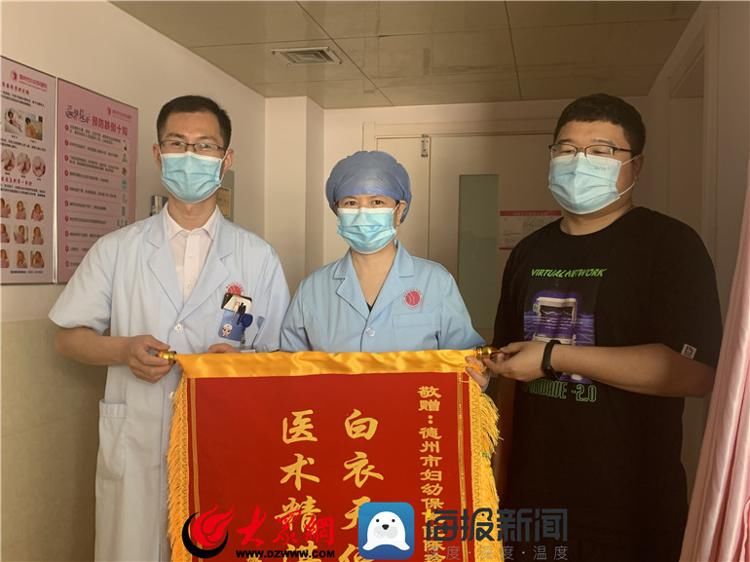
Dazhong Net·Poster reporter Li Lei reported from Dezhou
Recently, Dezhou women and children The obstetrics department of the health hospital urgently treated a woman with placental abruption. Due to the timely treatment, the mother and child were in stable condition. The family members of the mothers praised the obstetrics team of the hospital and sent pennants and letters of thanks in person.
Ms. Shi, 31 years old, came to the Obstetrics Department of Dezhou Maternal and Child Health Hospital on May 13 because of “32+1 week of menopause and positive urine protein for half a day”. After examination, Han Peiyin, deputy chief physician of the obstetrics department, found that the puerpera had obvious edema in her lower extremities for nearly half a month, and her urine protein was positive. Although her blood pressure did not meet the criteria for diagnosing gestational hypertension, the fetal heart rate monitoring could not be perfect every time. Sexual preeclampsia. After the mother is admitted to the hospital, the obstetric medical team closely monitors the mother’s blood pressure, general symptoms, and the fetal heart rate of the fetus.
“A few days before the hospitalization, the puerpera thought that she was not feeling well, and she did not understand the doctor’s order to continue hospitalization and observation, and always wanted to be discharged.” Han Peiyin patiently told the puerperium that although her blood pressure was at the critical value, her urine protein Abnormal, this situation sometimes progresses rapidly, prone to cardiovascular and cerebrovascular accidents, placental abruption or intrauterine stillbirth, and fetal heart monitoring is always substandard, the hospital has this concern. In the end, Ms. Shi followed the advice and was hospitalized for observation with peace of mind.
On the evening of May 19, Han Peiyin found that the maternal fetal heart rate was obviously abnormal. Suspected placental abruption and decided to terminate the pregnancy by emergency cesarean section, and immediately activated the emergency plan. The emergency team only took 13 minutes from preparation to operation. 2 minutes to cut out the baby. At present, the mother is recovering well, and the vital signs of the newborn are stable, and they continue to be observed in the hospital. Mr. Li, a family member of the mother, was still very excited when he recalled the scene that day. “I was stunned at the time, and I saw the doctor rushed to the operating room in an emergency. If it weren’t for the superb skills and timely disposal of the medical staff, the consequences would have been unimaginable.” Mr. Li will A specially customized pennant and a thank you letter were sent to Han Peiyin to express his gratitude.
“Gestational hypertension refers to a group of diseases that coexist with pregnancy and elevated blood pressure.” Han Peiyin introduced that pregnancy-induced hypertension, preeclampsia, eclampsia, and pregnancy complicated with chronic hypertension, chronic hypertension Concurrent preeclampsia is a common obstetric disease. The clinical manifestations of this group of diseases are diverse, including elevated blood pressure, proteinuria, edema, damage to multiple organs in the whole body, and severe cases may have convulsions (eclampsia), coma, etc., which seriously affect the health of mothers and babies, and lead to maternal and perinatal deaths. one of the main reasons.
“The daily management of pregnant women should focus on rest, diet, weight control and smoking cessation.” Han Peiyin said that for high-risk groups, moderate exercise, reasonable diet, calcium supplementation and indications during pregnancy should be used. Doses such as aspirin can reduce the risk of developing the disease. During pregnancy, you should ensure adequate rest, eat a healthy and regular diet, and ensure a comprehensive and balanced nutrition. During pregnancy, an appropriate low-salt diet is recommended, and moderate physical activity every day, such as walking, can help control blood pressure.
The successful treatment is the result of the obstetric team’s daily emergency drills for various emergencies. In the obstetrics team, there are “whistleblowers” who find problems, decision makers at the last minute, executors who eliminate problems, and new troops who follow orders. During the rescue process, the medical and nursing team truly achieved a clear division of labor and efficient rescue, escorting the health of mothers and babies.